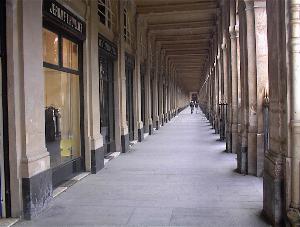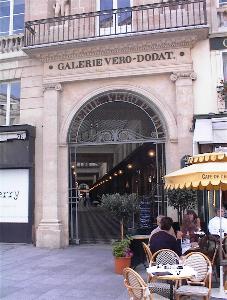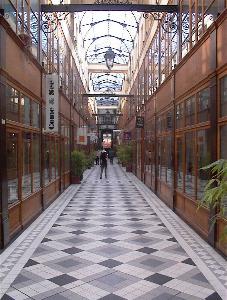|
Having admired these arcades (the floor mosaics are especially beautiful) we continue turning right into rue des Petits-Champs. We pass the Bibilotheque Nationale after some 700 metres (right hand) we get to the entrance of the Passage Choiseul (7).
This is a more workaday arcade. The shops are simple and above all
afordable. Cheap clothing, stationary and other everyday goods are on
offer here and some bars and cheap dim sum eateries. We sit down
for lunch at one such Chinese joint for lunch. The well known but
controversial novellist Céline lived here at no. 67 and devoted
some lines to this arcade in his novel " "Death on Credit" (Mort à Crédit), but renamed it Passage
de Bérésinas. pass the Bibilotheque Nationale after some 700 metres (right hand) we get to the entrance of the Passage Choiseul (7).
This is a more workaday arcade. The shops are simple and above all
afordable. Cheap clothing, stationary and other everyday goods are on
offer here and some bars and cheap dim sum eateries. We sit down
for lunch at one such Chinese joint for lunch. The well known but
controversial novellist Céline lived here at no. 67 and devoted
some lines to this arcade in his novel " "Death on Credit" (Mort à Crédit), but renamed it Passage
de Bérésinas.
We walk back through rue
des Petits-Champs up to rue Viviennes. We turn right here and at the T-junction  with Rue de Beaujolais we find the entrance to the gardens of the Palais
Royal (8).
Even these gardens are an oasis of quiet in this bustling city. On the
left side is the of the garden under collonades is the Galérie
de Valois. On the right hand side is the Galérie de Montpensier.
In the former we find a purple coloured perfume store by Serge
Lutens (no
142). At the end of the garden we walk into the court yard of the
Palais
Royal, with the remarkable black and white striped colomns, who were
put here in 1982 by Daniel Buren, commissioned by the flamboyant
Culture minister Jack Lang. with Rue de Beaujolais we find the entrance to the gardens of the Palais
Royal (8).
Even these gardens are an oasis of quiet in this bustling city. On the
left side is the of the garden under collonades is the Galérie
de Valois. On the right hand side is the Galérie de Montpensier.
In the former we find a purple coloured perfume store by Serge
Lutens (no
142). At the end of the garden we walk into the court yard of the
Palais
Royal, with the remarkable black and white striped colomns, who were
put here in 1982 by Daniel Buren, commissioned by the flamboyant
Culture minister Jack Lang.
We leave the gardens through a gate leading to the Place
de Valois and continue straight on into rue de Montesquieu. We end up at Galerie
Vero-Dodat
(9) . This is a very posh arcade, yet a little gloomy. The arcade was
named after two butchers who set up the arcade in 1824. At no. 24 we
find  Mr Capia the doll repair man. A unique shop full of antique dolls and
their attire, where time seems to have gone by unnoticed. Ohter shops
include a book shop and a shop for musical instruments.
Mr Capia the doll repair man. A unique shop full of antique dolls and
their attire, where time seems to have gone by unnoticed. Ohter shops
include a book shop and a shop for musical instruments.
Coming out of the arcade we turn left into rue J.J. Rousseau followed by right turn into rue Colonel Driant and left again into rue du Louvre . Then right into de rue Coquilleres. We are passing the modern Jardins des Halles, laid out on top of a underground car park .
At the end of rue Coquilleres stands the St Eustache church.
During the Paris Commune of 1870 a woman preachted on the abolition of
marriage. In one of the side chapels hangs a naive work of art
called "The departure of the fruit and vergetables form the heart of Paris 28 February 1969" . It commemorates the demolition of the Food Halls, the wholesale food market that stood here for centuries. We turn left at the church into Rue du Jour. Next we cross rue Etienne
Marcel and going right we keep left into rue Tiquetonne in. We cross the busy market street rue Montorgueil  and turn left into rue Dussoubs. We arrive (right hand side) at the Passage du Grand Cerf.
(10) This is the most stylish of all arcades. Lots of cast iron
decorations, glas roof and wooden shop fronts. The shops are filled
with decorative art. It is all very trendy and
"cool". The arcade is spanned by bridges connecting the upstairs
appartments. and turn left into rue Dussoubs. We arrive (right hand side) at the Passage du Grand Cerf.
(10) This is the most stylish of all arcades. Lots of cast iron
decorations, glas roof and wooden shop fronts. The shops are filled
with decorative art. It is all very trendy and
"cool". The arcade is spanned by bridges connecting the upstairs
appartments.
We get out on rue St Denis turning left into it
on our way to the last arcade. The rue St Denis is a bit sleazyg. We zig zag along prostitutes and cross the busy rue Réaumur over. After a few hundred metres we arrive at the passage de Caïre
(11). This arcade is despite its relatively modern outlook the oldest
(1798) of all the Parisian arcades. Its name is due to the Egypt mania
that raged in France after Napoleons expedition into Egypt.
Almost all shops are wholesalers suppling clothing to the nickle and
dime shops on rue St Denis. We
leave the arcade at the other end in rue d' Aboukir. We turn left here
and walk to the subway station Sentier at the junction with
rue Réamur.
|